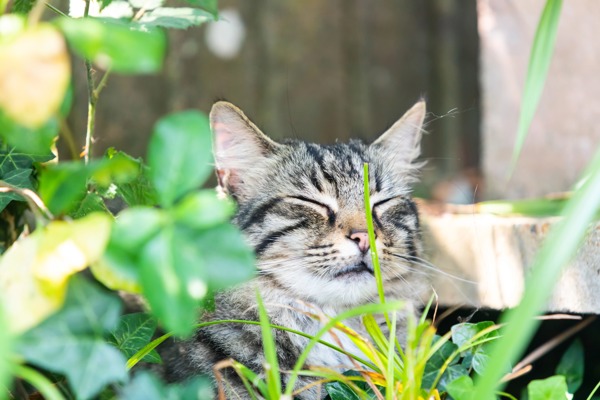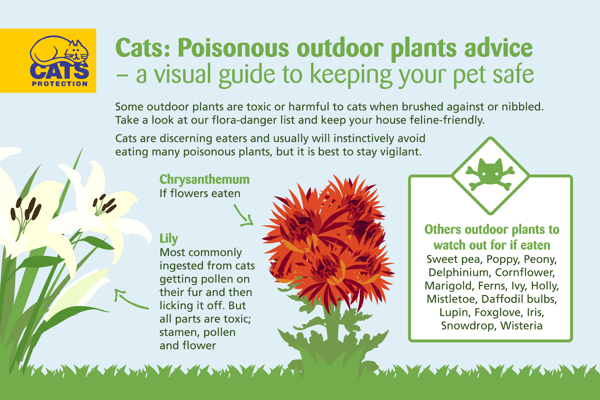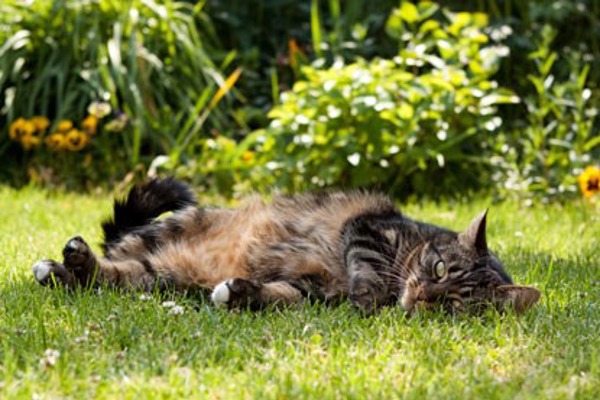Want to know how to make your garden more cat friendly? Here are some top tips and ideas for the best cat-friendly plants, flowers, trees and herbs for a UK garden
Throw those curtains wide, open the window and smell the spring air! It’s time to get back out into the garden and enjoy the warmth, the sun and the flowers. Our cats will also appreciate the balmier weather and a garden full of wonder and diversion.
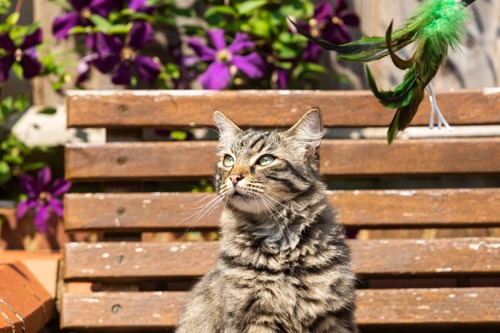
Here are some tips to get the best out of your outdoor space for you and your cat; creating a botanical adventure playground with cat-friendly plants, strategically placed pots, fallen logs and their very own poo patch.
1. Beware of plants that are dangerous for cats
The most important gardening tip for all cat owners is to avoid lilies both outdoors and inside the house. These are potentially fatal to cats and although fabulously fragrant and showy, they simply aren’t worth the risk to your cat’s health. Cats don’t have to deliberately chew on a lily (all parts are poisonous, including vase water), just brushing past it could shake pollen on their fur and prove toxic when they lick themselves clean. And while we’re at it, avoid nerium oleander and lily of the valley too.
When it comes to trees in your garden, cats are unlikely to chew on these or even try the berries or fruits, but note that members of the prunus family (including cherry, plum, apricot and peach) do have toxins, as do apple trees. Also ensure any pesticides used in the garden (organic or otherwise), such as slug pellets, are pet-safe. Or better still, don’t use them at all! Encourage natural pest control like hedgehogs into your garden for a greener solution.
Don’t panic when it comes to plant dangers. We have an extensive list of plants, flowers, trees and herbs to avoid, those to be aware of if your cat’s a nibbler, and those that are safe. Thankfully cats are usually very discerning when it comes to eating things and they’re more likely to be distracted by the wonderful playground that the garden provides. Find out more about dangerous plants.
Are daffodils poisonous to cats?
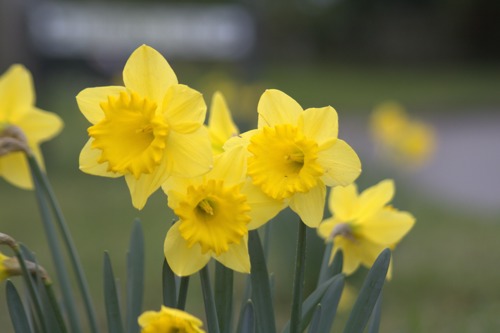
Daffodils contain toxins that would cause issues if your cat were to ingest them. Like other flowers such as tulips, allium etc there is more toxin concentrated in the bulb part (which is why we always advise to keep these out of reach before planting, and plant them deep in the ground), but there are toxins in the leaves and flowers too. Again, it comes down to whether your cat is a nibbler. If they are then it’s best to avoid planting daffodils.
2. Escort your cat
For their first forays into the garden, or if you have a nervous cat, escort them outside and give them your reassuring protective presence, making sure they always have a safe route back inside if they need it. It’s also a good excuse for you to get out and enjoy the garden!
3. Plant some cat-friendly outdoor plants
![]()

- Buddleias – these glorious plants are safe for cats and also provide them with great entertainment in the form of pollinating butterflies and bees. Buddleias come in a variety of colours and are very easy to grow, flowering from early to late summer. They love a sunny position and pruning should be done ‘hard’ in early spring or lightly after flowering
- Catnip – as we all know, some cats go mad for catnip, so why not plant it in your garden? It’s official name is nepeta cataria and it is a leggy plant with white flowers spotted with violet. It needs a sunny position with well-draining soil. Your cat may love it although you may find other addicts passing by to have a roll! (There may be some confusion between catmint and catnip. Both are members of the mint family but catmint is nepeta mussinii and used more for human culinary purposes. It has smaller leaves and violet flowers. This can be toxic but would have to be ingested in large quantities)
- Cat-safe grass – grass seed can be bought at most garden centres these days, including pots of fully grown grass for those of us less green fingered. Good types are spelt wheat, barley and oat grasses. However, don’t let the grass turn to seed as many have awns (seeds) that are like small arrows that attach to a cat’s fur and can burrow down. And on the same topic, avoid wood avens and get rid as soon as you see them. Yes, they look pretty when their bright yellow flowers are in bloom but the awns are a nightmare! Find out why cats eat grass
4. Create an outdoor toilet
Dig up a spare patch of soil to keep for your cat’s personal loo. If they’re toileting within their own garden, then this is sure to be a win with your neighbours! Remember to dig it over regularly and don’t put the poo on the compost heap or down the loo due to the parasite toxoplasmosis. When clearing the area use gloves and always keep children away. Keep the patch in a discreet, protected place where your cat can feel safe and won’t be jumped on mid poo. To keep your cat from pooing elsewhere in the garden try placing small pebbles around plant beds, and see the section about plants cats don’t like below.
Hopefully the cat latrine will stop them toileting in other garden beds, but again it’s best to wear gloves when gardening, just in case you come across a stray poo. Also remember to keep a litter tray in the house so your cat has the choice if they want to toilet inside, for example in bad weather! Find out more about cats and toileting.
5. Provide shade from the sun

Bushes such as Mexican orange blossom (evergreen with white star-shaped flowers), ceanothus (another bee and butterfly favourite) and sword fern can give your cat a safe place to hide and relax, and shade from the sun. You could also have a small garden table which they can sit on during good weather, and underneath when it’s raining. Find more advice for caring for your cat in warm or cold weather.
6. Outdoor scratching opportunities
Thick tree trunks with rough bark can give your cat a giant vertical scratching post, and large, sturdy logs can give your cat a horizontal option. They can also provide a great refuge for the local insects! Find more advice about cats scratching.
7. Create perches and escape routes
Cats love to get up high so they can observe their territory. Placing a ladder up to the shed roof gives them access to somewhere up high with a great vantage point of the garden. Cat shelves could be placed on walls or sturdy fences, but remember that with all elevated perches the best ones are those that are close to the house and face out to the garden, giving your cat a good view and a quick route safely back inside.
If your cat likes sitting on benches try and keep the back of the bench against a shed, fence or wall, to give them that extra sense of security, but not the wall that neighbour’s cat likes to leap up on – no one likes to be crept up on from behind when taking a snooze in the sun.
Trees also provide good high up places but keep watch as cats can’t always get down as well as they got up. A hole cut into a fence or gate can give elderly cats easier access to the garden, and also allow quick access if being chased.
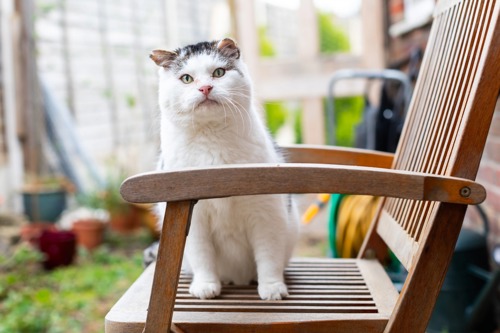
8. Create hiding places
Planting flowers in pots can not only help protect delicate plants such as violas, snapdragons and calendula from trampling paws but they are also moveable hiding spaces for your cat. By watching their favoured routes, you can then place the pots strategically allowing them optimum hiding opportunities. And if they change their route you can move the pots accordingly! Pots can also be placed around the cat flap or door, and also around their poo patch. This allows your cat to carefully check out their territory before venturing forth. Just make sure they are not being used by any local cats waiting to ambush your unsuspecting cat! Find out more about why cats hide.
9. Provide safe water sources
You can provide a bowl of water outside for your cat but they may be more attracted to your pond, a natural water source untainted by chemicals. As for all creatures, ensure the pond has gently sloping sides and rocks that can be used to climb out on in case they tumble in. A metal grid/mesh just below the surface can be added for extra safety. Don’t worry if you have water lilies on your pond, these are not true lilies and are safe for your cat. Water features, such as pondless fountains whereby the water reservoir is hidden beneath the ground like a millstone with gently bubbling water, are another favourite with cats. But do not put any chemicals or anti-freeze in these! Also make sure waterbutts have a secure lid to prevent your cat from falling in. Find out more about what cats like to drink.
10. Keep your cat in the garden
If you would prefer your cat to stay within your garden boundaries you can get cat-proof fencing, and hedges along the perimeter can also help. But you may not be able to keep a determined cat contained, so ensure their microchip details are up to date in case they go missing.
11. Make the garden safe for other animals too
For your feathered friends make sure that bird tables and bird feeders are protected. Put plastic bottles around the stand to stop cats from climbing up, or use feeders with thin poles. Don’t plant big shady bushes near these as they’ll provide a good spot for your cat to hide and pounce from. It’s a good idea to keep your cat in at night as they are most likely to hunt at dusk and dawn. There is also a higher risk of cats being involved in road traffic incidents at night, another good reason to keep them inside.
Plants cats don’t like
If you’re thinking about plants that will deter cats from your garden altogether, then there aren’t many effective ones. There are some worth a try but beware of the marketing hype. As with catnip, it depends on the cat. Here are some plants that could be given a try to deter cats.
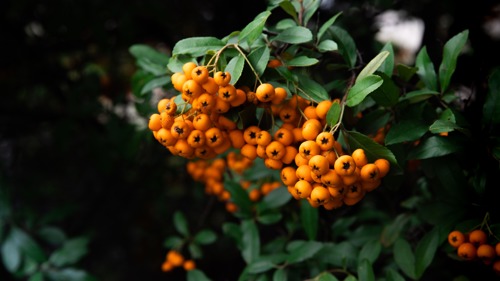 Pyracantha
Pyracantha
Smelly plants – These emit strong odours when brushed past:
- scaredy cat plant (coleus canina) – apparently bred deliberately to be a pest repellent as the odour, like dog pee, is unpleasant to cats… and probably humans too!
- rosemary
- lavender – if slightly crushed it can release essential oils that are toxic to cats, causing vomiting and inappetence. These are unlikely to be released in great quantities but it’s best to be wary
- curry plant (grey foliage with yellow flowers)
- lemon balm – cats aren’t supposed to be keen on citrus smells or the rough foliage
Spiky plants – These can be planted near bird tables or to prevent cats from climbing fences:
- pyracantha – grows tall and the birds love their berries. Also can be trained over fences or gates for extra security!
- quince – birds ignore the spikes and the fruit is great for humans making quince jelly
- shrub roses – remember to go for the thornier ones
Find more advice for keeping your cat happy and safe outdoors.

